A Study on Tibetan Refugees of Chandragiri, Odisha
Dr. Kanhu Charan Satapathy
| Introduction | Food habits and food Culture of Tibetans in Odisha |
| Methodology | Economy |
| Results | Education |
| Initial Stage of the Resettlement | Health |
| Religion and culture | Conclusion |
| Forms of Marriage |
Abstract In the present study an attempt has been made to explore the coping strategies of Tibetans in exile in India. Tibetans who are in their fourth generation in exile in India passes through different difficulties as they moved from high altitude Tibet to low altitude like their settlement in costal Odisha. In spite of difficulties such as environmental, cultural, linguistic and psychological they arise as one of the most successful population in exile and are struggling to get their freedom.
Keywords: High altitude, Tibetans and Migration.
Introduction
Humans as a species are considered one of the most generalized species inhabiting earth. Human populations can be found at widest possible geographical and environmental regions. Approximately 20 to 30 million people all over the world live permanently at an elevation of 3,000 meter or higher and are exposed to a harsh environment, known in scientific parlance as ' high altitude', which in reality comprises a constellation of stress, namely, hypobaric hypoxia, cold, rugged terrain, solar radiation, wind, precipitation and lesser seasonal variation in temperature (Heath et al., 1995, Gupta, 1989). Similarly, people who are living in high altitude areas are economically the least developed one and their diet is monotonous because of ecological condition and limited food resource (Gupta, 1980,1989). Research on different high altitude regions such as Himalayan, Ethiopian, Andean and Tien Shan-Pamir conducted independently by different scholars (Baker, 1969; Pawson, 1974; Goldstein, 1978; Beall, 1981a; Weitz, 1978) reveal that Tibetans are a unique high altitude population inhabiting the Himalayan region since pre historic time (Chang, 1981; Weiwen, 2001). Moore and others (1998) and also show that archaeological, genetical, geographical, historical and linguistic data support the likelihood of a temporal gradient in which Tibetans have had the longest duration of high-altitude residence as compared to other high-altitude population of the world. Further, they also point out several physiological distinctions possessed by the Tibetans that induce them adaptive advantages arose probably due to their greater generational length of high altitude residence. Of the three major highland areas in the world, the Asian highland region, the Tibetan plateau, provides for the higher possibility of microevolution compared to American highlands of Andes. This is because of the much earlier inhabitation of Asian highlands by Humans than American highlands (Bellezza 2001, Weiwen 2001), and also due to more severe environmental stress compared to American and African highlands.
There has been some migration of high altitude populations to lower altitudes where the succeeding generations have grown up without the stress of hypoxia such as Tibetans in Odisha. Tibetan plateau represents the world's largest and highest land mass. The average elevation is more than 4500 meters. The present Dalai Lama with many of his followers fled Tibet in 1959 and entered India. The Government of India gave Tibetans asylum and settled them at different parts of the country. They number around 85,147 according to Tibetan Demographic Survey (1998) and more than 110,000 according to the estimates of USCR (1999). The different parts of India offer them different climatic and cultural environments, to which they had earlier been alien to (web page of department of Home, The Government of Tibet in Exile, 1996). Their settlements in Leh/Ladakh are more or less similar to the climatic environment in Tibet. In contrast, the settlements/colonies in Odisha, Himachal Pradesh, Arunachal Pradesh, Karnataka, Delhi, and elsewhere offer them a range of climatic setting which range from moderate high altitude to low altitudes which is quite in contrast to the climate of Tibet (cold, low humidity and hypoxic). They have been living in India for last 50 years and a whole generation have been born and bought up in different contrasting environments at different settlements.
Methodology
The Tibetans settlement in Odisha was established in 1963 at Chandragiri on Eastern Ghats, which is at an altitude of 930 meter and is also very near to coastal area as well as away from the urban centers drastically different from their homeland Tibet. The settlement started with an initial population of 2500 and reached approximately to 3,600 in 2001. This study is based on fieldwork data collected between February 2003 and September 2004. A total of 578 households were selected from five camps and have been surveyed for socioeconomic and demographic investigation. Appropriate schedules and questionnaires were used for the collection of demographic, socio-economic, dietary, and health studies. However, data from secondary sources like hospital/dispensary records etc were also used in the present study.
Results
His Holiness Dalai Lama escaped Tibet from his winter palace, Potala, to India, on 17th March 1959 along with few of his bodyguards. He was able to enter India only on March 31, 1959 near Tawang in Assam. H. H. the Dalai Lama gave three main reasons for the Chinese attack on Tibet. First Tibet had a vast space with sparse population. Hence the Chinese intended to use Tibet as an extra space to live. Secondly, since the Tibetans had no desire for worldly riches they did not exploit the rich resources of the land while the Chinese declared the enrichment of their country at the cost of Tibet. Thirdly the Chinese intended to dominate Asia and the conquest of Tibet was a first step in this regard (Arakari, 1998).
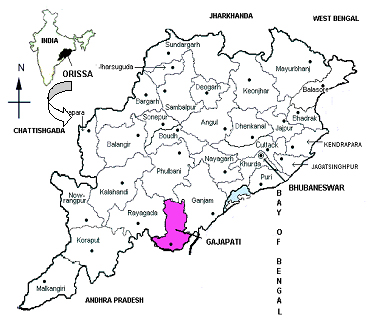
Fig..1 Map showing the Tibetan settlement in Odisha
Tibetan Settlement in Odisha: The Phuntsokling Tibetan Settlement area, Chandragiri consists of sixteen villages namely: 1. Chandragiri 2. Sagada, 3. Tankilipadar, 4. Labarsinghi, 5. Mohendragsda, 6. Khasada, 7. Burapada, 8. Rankuda, 9. Anangapur, 10. Anangadangar, 11. Padadigi, 12. Jiranga, 13. Lampada, 14. Kantasaru, 15. Kanakarada and 16. Raipur.
| Camp Nos. Local Name | No. of Families | No. of Population | Agricultural Land in Acres |
| Camp I:Chandragiri | 125 | 615 | 517 |
| Camp II:Tangelypader | 36 | 215 | 82 |
| Camp III:Lobersingh | 124 | 714 | 722 |
| Camp IV:Zerango | 42 | 397 | 200 |
| Camp V:Mahendragdh | 251 | 1300 | 387 |
| Total | 578 | 2609 | 1980 |
Table 1: Camp wise distribution of Tibetan's in Chandragiri, Odisha.
"PHUNTSOKLING",the name given to the settlement which means " Abobe of Plenty and Happiness", is located at Chandragiri in Gajapati District of Odisha State. It is also the only Tibetan settlement in the State. It was set up in 1963 by the Government of India and the State Government to resettle 2479 Tibetan refugees who had escaped into India in the aftermath of Chinese occupation of Tibet. Chandragiri and the surroundings were once a dense forest area and no human beings dared to go out freely even in the daytime for fear of wild animals. Now it has become maize "bowl", and center of attraction for many to see quality Tibetan hand made artifacts, cute little Tibetan dogs called APSO and Buddhist monasteries. It is situated at the elevation of 3200 feet above the sea level. It has a tropical climate with an annual rainfall of 3200 mm and temperature ranging from 10o C in winter to 38o C in May, the hottest month. The area is characterized by high hilly region of Eastern ghats. The Topography of the area is undulating characterized by high hills of remarkable similarity in appearance. The principal source of drainage is a stream, which originates from the southern highlands and its numerous tributaries. However, recent finding reveals that the settlement has population of more than 3800 consisting of 600 households (Chhotoray, 2011), which are divided into five camps. All except camp No. 4 are located on the side of the main road. It has thus good accessibility and communication networks.
|
Age Group |
No. of Male |
No. of Female |
Total |
Sex ratio |
|
0-1 |
21 |
24 |
45 |
1142.8 |
|
1-4 |
78 |
68 |
146 |
871.7 |
|
5-9 |
115 |
123 |
238 |
1069.5 |
|
10-14 |
153 |
152 |
305 |
993.4 |
|
15-19 |
151 |
142 |
293 |
940.4 |
|
20-24 |
142 |
139 |
281 |
978.8 |
|
25-29 |
107 |
118 |
225 |
1102.8 |
|
30-34 |
76 |
70 |
146 |
921.0 |
|
35-39 |
79 |
78 |
157 |
987.3 |
|
40-44 |
70 |
45 |
115 |
642.8 |
|
45-49 |
33 |
38 |
71 |
1151.5 |
|
50-54 |
50 |
50 |
100 |
1000.0 |
|
55-59 |
48 |
44 |
92 |
916.6 |
|
60-64 |
75 |
53 |
128 |
706.6 |
|
65-69 |
71 |
54 |
125 |
760.5 |
|
70-74 |
35 |
26 |
61 |
742.8 |
|
75-79 |
25 |
26 |
51 |
1040.0 |
|
80+ |
17 |
13 |
30 |
764.7 |
|
Total |
1346 |
1263 |
2609 |
938.4 |
Table 2: Population Composition and Age Sex specific sex ratio of Tibetans in Odisha
Above table shows that age sex specific sex ratio of Tibetans in Odisha and it seen that there are 938.4 females per 1,000 males.
Age and Sex pyramid: With its thin base, building middle and tapering top, the age pyramid of Tibetans in Odisha represents an unusual reduction of child and middle-aged population due to a decline in fertility and mortality.
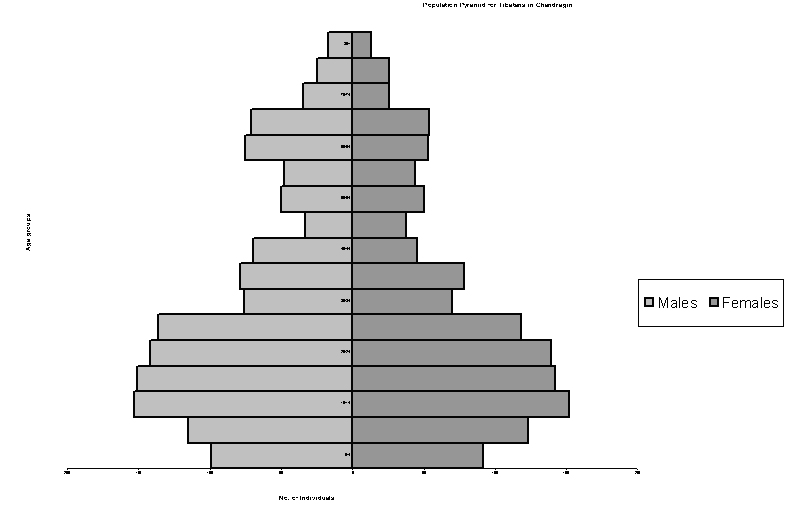
Figure 2. Population Pyramid of Tibetans in Chandragiri, Odisha
A prominent constriction is observed at the base of the pyramid, which represents the age group 0-15. Above this thin base the middle of pyramid is broad and then it tapers irregularly towards the top. The pyramids have unusual constriction in the age group of 45-59 above which it again expands a little before tapering towards the top. This constriction at the top reflects high mortality for the growing ages some 40-45 years back. The stress of morbidity faced by Tibetans was maximum when they came to India. The environment (especially the disease environment) was such that they had never faced it before. Children must have been the worst affected in term of mortality and this gets reflected in the pyramids. The situation improved in terms of socio-economic status and medical facilities after the initial hic-ups of settling at new places, which resulted in an increasing population till 10-15 years back, after which a trend towards declining population is seen. Hence, this population is considered as in demographic transition (Satapathy, 2010, Bhatia et al 2002).
Table 3: Migration of Tibetans in Odisha from different provinces of Tibet
|
Name of the Province |
No. of households (n=578) |
% |
|
U-Tsang(Central Tibet) |
497 |
85.99 |
|
Amod Provience |
29 |
5.01 |
|
Dotoe(Kham) |
52 |
9.00 |
|
Total |
578 |
100.00 |
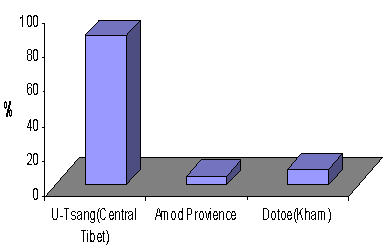
Figure 3: Migration of Tibetans in Orissa from different provinces of Tibet
From the above table 3 and figure 3 it has been observed that most of Tibetans (85.99) belongs to U-Tsang (central Tibet), 5.01 percent belongs to Amode provinces and 9.00 percent belongs to Dotoe (Kham) regions of Tibet.
Initial Stage of the Resettlement
The settlement was established in two phases. In the fist phase, 585 people arrived from road camps in Chamba, Dalhousie and Bomdila in mid 1963. They were mostly accommodated in Camp No. 1. In the second phase, between 1964 and 1967, the settlers for the remaining four camps arrived. Kucha houshing made of mud-plastered bamboo wall with sheet roofing was ready only for those settlers coming in the first phase of refugees. Land clearing for agriculture and houshing for other camps were yet to be done. Assisted by the Odisha State Government, American Emergency Committee for Tibetan Refugees (AECTR) and Swiss Techinical Co-opereation and with settlers' labour, the land cleaning and reclamation works were started in 1963 and by the end of 1968, entire land clearing works, reclamation, construction of houses, digging wells, construction of check dams and other residuary resettlement works had been completed. The settlers were paid in rations. This was the first phase of settlers in building a new life in the settlement. Of course, it was also the most difficult period for them too. Coming from entirely different climatic and cultural background, adaptation and adjustment to the hot tropical climate was difficult and it took a great toll on the mental and physical energies of the settlers. Facilities for existence were bare minimum. All of them were poor and penniless. The settlers had to do hard manual works in hot sun and torrential rain. The area was infested with mosquitoes and wild animals. Hardships and vigour of starting a new life was too great. As a result, many died of diseases, malnutrition, heat and depression. The settlers were supported with ration for the first two years and after which they were supposed to support themselves through framing. Unfamiliar with tropical framing which was completely different from traditional broad casting method practiced in Tibet, the settlers could not produce enough even to feed themselves. At one point, situation had become so desperate that most of the settlers thought it would disintegrate. It was at that time in late 1960s, Dharamsala requested the Swiss Technical Co-operation to assist the settlement. Under the dynamic and forceful leadership of Mr Ludl, the Swiss Techno brought fleet of tractors, established workshop and taught modern farming methods with introduction of maize cultivation. They helped to clear fields of tree stumps and contour bounded them. They helped the construction of a series of Checkdams for conserving runoff water and a large grain storage facility in each of the five camps. It also established a carpet-weaving center. This injection of developmental aid by the Swiss Techno infused a new lease of life. Sense of despair and hopelessness were dispelled. Spirit of hope and regeneration were kindled.
Religion and culture
Preservation of the Tibetan religion and culture was one of the important reasons for Tibetans coming to India, as it was not possible under Chinese communist occupation. Establishing the Tibetan settlements was therefore aimed towards realizing that goal. Had there been no separate settlements, all Tibetan refugees would have disappeared in the sea of Indian masses, and it would have been the end of unique Tibetan culture and religion. With the separate settlement for Tibetans, it became possible for the settlers to celebrate all the major Tibetan religious and cultural festivals in the settlement with great enthusiasm. Among the festivals, the Tibetan New Year is celebrated with great pomp and show. It is an occasion for all family members to reunite and live together no matter wherever they may be living unless it is totally unavoidable. Every family has an alter for prayer. They invite monks to their houses at the time of birth, death and sickness to give blessings. To keep alive the important dances and traditions, and pass them to the younger generations, there are three dance troupes in the settlement- Lamo, Gyashey & Lingdro. They give performance during important public gathering and functions. The settlement has also three monasteries to preserve their traditional lineage and also to fulfill the spiritual needs of the people.
|
Forms of Marriage |
No. of Households |
% |
|
Monogamy |
498 |
86.16 |
|
Polygamy |
80 |
13.84 |
|
Total |
578 |
(100.00) |
Table 6: Forms of Marriage in Tibetan Settlement, Odisha
Polyandry, which can seldom found in other part of the world, is popular in Tibet (Goldstein, 1971 and Ma, 2001). Fraternal polyandry, a culturally highly valued practice in Tibet (Nancy et. al, 1997) is losing its importance in Odisha, which could be due to the impact of local culture where polygamy is less frequent. From the above table it has been observed that 86.16 percent belongs to monogamous type of marriage where as 13.84 belongs to polygamy type (Fraternal Polyandry and Polygamy) in Odisha settlement.
Food habits and food Culture of Tibetans in Odisha
High altitude Tibetans has a unique food habits in their homeland Tibet because of the high altitude environment (Gupta et al 1989). Nutritionally the high altitude population exhibits lower intake of calorie, protein, mineral and vitamins (Gupta, 2013) Their migration to low altitude leads to not only change in their way of living but also marked in their food habits.
Table 5: Food Habits of the Tibetan Refugees in Odisha, a Qualitative Analysis
|
Hour |
Odisha |
Tibet |
|
Break fast |
Bread, Tea (with sugar), Butter milk, Chili paste |
Pag, tea (with out sugar) butter, zhara etc |
|
Lunch |
Rice, Dal, Bred, Vegetable curry, Non Veg (Chicken, Mutton & occasional Beef and Pork, Fish and Dry fish), Chili paste, Fruits |
Bread, vegetable curry, Non-veg (Pork, Yak meat etc.) |
|
Dinner |
Tingmo, Bread, Rice, Dal, Veg and Non Veg (Chicken, Mutton & occasional Beef and Pork, Fish and Dry fish), Chili paste. |
Pag, nutul, vegetable curry, non-veg curry. |
Food habits of Tibetans in Odisha are different from their native place Tibet. Table 5 shows the various types of food used by Tibetans for break fast, lunch and dinner in Orissa as compared to their homeland Tibet. It has been also observed that fruits, vegetables, spices, sugar, fish etc. is also added in their diet in Odisha. In terms of nutritional status Tibetans in Odisha exhibits a better picture when compared with local communities (Patel, 1985;Bera, 2004; Tripathy et al. 2006).
Economy
Agriculture is the main stay of the settlement economy, which is supplemented by sweater selling during the winter months in various Indian towns and cities. There are 1800 acres of cultivable land. Maize is the main cultivated crop followed by millet cultivation. However, gradually farmers have taken interest in vegetable cultivation in kitchen garden supported by the Danish government agricultural project. Most of the camps have Guava community orchards. Each family has also a few Guava trees and other fruits like Papaya, Castor Apple, and Jackfruit in their backyards. Most of the families also keep a few cattle mostly local breed for milk as well as for ploughing. To assist the settlers in economic activities, the Multipurpose Tibetan Co-operative Society was formed way back in 1966. It operates an agriculture marketing section which purchases farm inputs in bulk and supplies them to the farmers on credit and helps in marketing their produces; a Mechanical Workshop and tractor section for field tractorisation and maintenance of the tractors and other farm equipment; a handicraft section for training and production of carpets and other traditional handicrafts; provision shops for daily essential items and flour mills to grind grains for human and animal consumption.
Education
The settlement has a comprehensive education facility from crèche upto secondary level. Every child has accesses to education facility. Each camp has a crèche and kindergarten unit run and managed by settlement office. It has two primary schools and one secondary school run by the Central Tibetan School Administration, an autonomous body of the government of India. The medium of instruction throughout the schooling is English but the children also learn Tibetan language, literature, culture and religion in the school. Table 6 reveals that the present generation not only exposing to modern education but also losing interest towards Buddhist education in the Odisha settlement.
Table 6: Educational Status of Tibetans in Odisha
|
Educational status |
Male (%) |
Female (%) |
Total (%) |
|
Illiterate |
360(13.80) |
464(17.78) |
824(31.58) |
|
Primary |
224(8.59) |
172(6.59) |
396 (15.18) |
|
Middle |
246(9.43) |
246(9.43) |
492(18.86) |
|
Secondary & above |
424(16.25) |
350 (13.42) |
774 (29.67) |
|
Buddhist education |
120(4.60) |
3(0.11) |
123 (4.71) |
|
Total |
1374(52.66) |
1235(47.34) |
2609(100.00) |
Health
The settlement has a good health facility. With the help of Tibetan Health Department and community contributions, a dispensary was established which was later expanded with 12 bedded ward and TB isolation ward. It is manned by one resident doctor, a nurse and five community health workers, one-laboratory technicians and one dental therapist. There is a Primary Health Center at Chandragiri run by the State Government. The Tibetan Medical center, Dharmashala is also running a dispensary providing traditional herbal medicine. These facilities are accessible to both the settlers and local Indians without any distinction. Besides TB the major health problem for Tibetans in Odisha is Malaria (Satapathy, 2009& 2010).
|
Disease suffered from |
Year 2000(%) |
Year 2001(%) |
Year 2002(%) |
|
Malaria |
27.63 |
32.57 |
27.09 |
|
Upper R.T. |
18.18 |
13.30 |
14.42 |
|
Lower R.T. |
5.50 |
4.33 |
6.17 |
|
Tooth ache, head ache etc. |
6.19 |
5.51 |
11.59 |
|
Hypertension/Cardiovascular |
7.16 |
7.60 |
7.21 |
|
Skin disease |
8.14 |
9.19 |
6.96 |
|
Abdominal pain, Dyspepsia |
6.02 |
6.27 |
5.41 |
|
Diarrhea |
5.57 |
3.61 |
3.48 |
|
Fever |
4.85 |
5.73 |
5.52 |
|
Joint pain |
3.51 |
4.67 |
5.27 |
|
Injuries/Burns/Bites |
2.50 |
2.39 |
2.08 |
|
Ear/Eye condition |
2.50 |
2.28 |
2.36 |
|
T.B |
0.29 |
0.26 |
0.32 |
|
S.T.D/UTI |
0 |
0.53 |
0.03 |
|
Diabetics |
0.06 |
0 |
0 |
|
Worms |
0.78 |
0.64 |
0.60 |
|
Mal-nutrition (Anemia) |
1.04 |
1.06 |
1.50 |
Table 7: Morbidity pattern in the Tibetan refugee camp during 2000-2002.
For the present study, the morbidity statistics of local hospitals were taken into consideration. It is observed from table no. 7 and figure 4, that the major group of diseases affecting health status of the studied population is fever, digestive disorder, skin disease, muscular disorder and disorder of joints, E.N.T., and accident. During the year 2000 malaria (27.63%), URT (18.18%), Skin disease (8.14%) and Hypertension/Cardiovascular disease (7.16%) etc were the major cause of morbidity among the Tibetan. In the same way during 2001 malaria was dominant (32.57%) as the major cause of morbidity followed by skin disease (9.19%), hypertension/cardiovascular disease (7.60%). It is also seen that malaria continued to be the major cause of morbidity even during 2002 (27.09%) followed by URT (14.42%), toothache/headache (11.59%), hypertension/cardiovascular disease (7.21%).
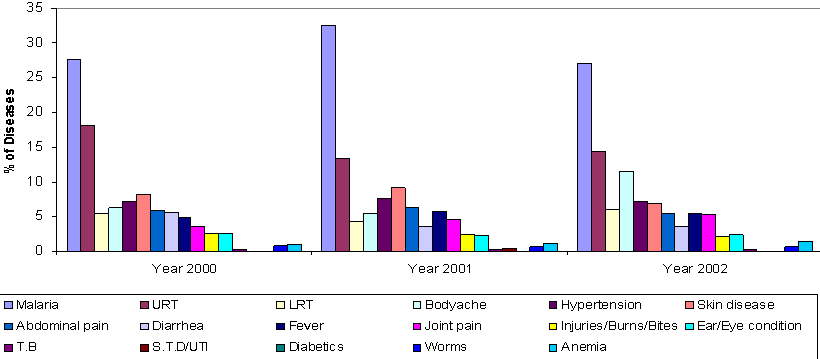
Figure 4: Morbidity pattern in the refugee camp during last three years
Conclusion
The Tibetan population in exile in Odisha has been in transition after having lived for over five decades in an uprooted condition. The initial needs of the Tibetan refugee population have now shifted towards the necessity of the overall development of the society. The Tibetans in Odisha have with hard work of their older generation and the economic support of various agencies, national and international, created a better life for themselves. However, the relations of Tibetans in India with the host country can be understood at two levels: firstly, at the level of Government of India, and secondly, at the community level. The Tibetan refugee settlements in India have been deliberately designed in such a way as to recreate Tibetan society keeping its core value intact, which is clearly observed in Odisha settlement. There are two critical aspects of the Indian policy towards the Tibetan refugees - the liberal "non-assimilative" framework as reflected in the separate settlements and the broad "delegated" authority of the Tibetan leadership headed by the Dalai Lama over the Tibetan settlements in India. Such a generous policy ensures to the Tibetans their cultural identity and social autonomy in a sea of host population. However, interaction between the Tibetan refugees and the host population is limited to the purpose of economic transactions. A number of Odiya labourers are engaged in the agricultural fields in Tibetan settlement in Odisha and such job opportunities have smoothed the relationship between the Tibetans and the locals. The establishment of Tibetan settlement at Chandragiri, Odisha has also brought benefits to the surrounding villages. The Tibetan hospital and schools cater to the needs of the host population also. Besides the tube wells that have been dug, the irrigation canals etc are open to the locals and thus the benefits.
As Tibetan refugees have settled successfully in Odisha even though it is a poor and harsh environment as compared to other settlements in India. The Tibetan refugees in Odisha do not present a picture of uprootedness like other refugee groups; however, their future is not as secure as it may seem because they still remain refugees in an alien situation. The refugee status of the Tibetans in their host country also created a feeling of uncertainty in their mind because they feel uprooted from their own land. This situation leads them to suffer mentally which is sometimes expressed in their behavioural pattern. So, the emergence of mental health problem among the youth is a major problem, which needs urgent attention. On the one hand, Tibetans in Odisha have contributed significantly to winter garment business, have made the land at Chandragiri cultivable particularly by the cultivation of maze and guava, and have helped a lot in restoration of Buddhist culture with the establishment of Asia's largest Tibetan monastery (2010) named after Guru Padmasmbava which is having historical link with Buddhist tradition of Odisha as well. On the other hand, their settlement at Chandragiri lead to deforestation as a consequence of which soil erosion and decline in the wild animal population has been observed in the locality. Tibetans in Odisha even after their five decades of stay have not been able to read and write Oriya language but are well versed in Hindi, English and their own language. As far as the identity of Tibetans in Odisha is concerned most of the local people identifying them as Nepalese because of their physical appearance. They are famous for their woolen garment business and for their good behaviour, which is reflected by their healthy relationship with the natives. Any conflict between the Tibetans and the local people has not yet been reported except for a few at the individual level.
The younger generation who has never seen Tibet has different types of difficulties, which require urgent attention. Significant changes are observed in their health, food habits, socio-economic condition, settlement pattern and dress pattern particularly among the Tibetan youths in Odisha.
As far as religion and culture are concerned, they maintain exactly what His Holiness Dalai Lama thought when he settled first in India. Financially this population in Odisha is not very sound except a few because most of them are dependant upon agriculture as well as seasonal business, and are serving in the settlement office run by the Tibetan government in exile. Those who are staying abroad as well as doing business in different cities round the year are having better income. It has also been observed that the local tribal people are even poorer as compared to the Tibetans.
Statehoodlessness, refugee's status, citizenshiplessness and their strong desire to return to Tibet soon, are the major obstacles in their overall development. Their settlements are distributed both in urban as well as rural areas in India, and in interior places like Chandragiri, Odisha. Many of them are also staying abroad which not only exposes them to different environment but also put them into various types of difficulties, which makes their life, even more complicated.
It has also been observed that both the State Government and the Tibetan Government in Exile have taken necessary steps for their upliftment particularly in the field of health care, tourism, restoration of Buddhist culture in Odisha and popularization of Tibetan methods of treatment. In this connection, the role of His holiness Dalai Lama is very much significant. However, in 2012 the movements started by the locals against the Tibetans brought new challenges for them, which need urgent attention.
Study on Tibetans in Odisha reveals that the population seems to be in a demographic transition and show a decrease in growth rate in the last decade. The intensity of migration, low birth rate and low infant mortality rate indicate the state of transition towards a higher level of socio-economic development. The exceptional improvement in educational status among the younger generation of Tibetan refugees has lead to the absence of a pro-male bias in educational opportunities in India compared to the traditional Tibetan society. However, the new generation of Tibetans may, in future, increasingly face serious problems of employment and engagement in economic activities suited to their education and skill, and this may lead them to suffer from economic insecurity and anxiety. Disease related to obesity such as hypertension, diabetes and cardiovascular disease, which are now observed in this population, need special care. Malaria disease is the major heath problem in the Odisha settlement. Diseases like tuberculosis, cancer, gastric disorder, STD are also observed in this settlement.
It is well marked in the present study that the main objective of the Tibetan government in exile is to motivate all Tibetans in India to preserve their language, tradition, culture, and national identity, and it also aims to secure for them food, shelter, medical care, education and livelihood so that they can achieve self-sufficiency.
Acknowledgment
This author is thankful to Prof. Ranjan Gupta, Head, Biological Anthropology Unit, Indian Statistical Institute, Kolkata and Prof. P. K. Das, Department of Anthropology Utkal University, Bhubaneswar, Orissa for their support in preparation of the present paper.
References
- Arakari AV. 1998. Tibetans in India: The Uprooted People and their Cultural Transplantation. Reliance Publishing House, New Delhi.
- Baker PT. 1969. Human adaptation to high altitude. Science 163: 1149-1156.
- Beall CM. 1981a. Growth in a population of Tibetan origin at high altitude. Annals of Human Biology 8(1): 31-38.
- Bellezza, J. V. 2001. Antiquties of Northen Tibet: pre-Budhist archaeological discoveries on the High Plateau. Adroit Publishers, Delhi.
- Bera S. 2004. Tibetan refugees in India: observations in the field of health. Journal of Indian Anthroologica. Society..39(2):183-194.
- Bhatia S, Dranyi T, and Rowley D. 2002. A social and demographic study of Tibetan refugees in India. Social Science & Medicine 54:411-22.
- Chang DHS. 1981. The vegetation zonation of the Tibetan platue. Mountain Research Development. 1(1):29-48.
- Chotorray, S. 2011. Are locals at peace with Tibet, Sri lanka refugees in Odisha. The
pioneer.http://www.dailypioneer.com/state-editions/bhubaneswar/18702-are-locals-at-peace-with-tibet-sri-lanka-refugees-in-odisha.html (Accessed on 12th Jan. 2012) - Department of Home, The Government of Tibet in Exile.1996.Website:http://www.tibet.com/G ovt/home.html.(accessed on 20/5/2003)
- Gupta R. 1980. Altitude and demography among the Sherpas. Journal of Biosocial Science 12: 103-14.
- Gupta R, Basu A, Pawson IG, Bharati P, Mukhopadhyay S, Roy SK, Majumdar PP, Bhattacharya SK, Bhattacharya KK, Das SK. 1989. Altitude and Human Biology: A Comparative Study of Himalayan, Andean and Ethiopian Data. In: Human Biology of Asian Highland Population in the Global Context. Ed Basu A and Gupta R. Pp. 1-80. 9 Indian Anthropological Society Occasional Papers, Calcutta.
- Gupta, R. 2013. Nutritional Adaptation in Man at high altitude: A Paradigm in Human Biology. S. Sengupta (Ed) Issuues and themes in Contemporary Anthropological Studies.Gyan Publishing House, New Delhi.
- Goldstain, M. C. 1971. Stratification, Polyandry, and Family Structure in Central Tibet. Southwestern journal of Anthropology. I27(1): 64-74.
- Goldstein MC. 1978. Pahari and Tibetan polyandry revisited. Ethnology. 17(3): 325-337.
- Heath D and William DR 1995. High-Altitude Medicine and Pathology. Oxford Medical Publication: Oxford University Press.
- Ma, Rang. 2001. Marriages and Spouse selection in Tibet. Development and Society. 30:79-117
- Moore LG, Niemeyer S, Zamudio S. 1998. Human adaptation to high altitude: regional and life cycle perspectives. American Journal of Physical Anthropology Suppl 41: 25-64.
- Nancy, E. L., and Sill, J. B. 1997. Why Polyandry Fails Sources of Instability in Polyandrous Marriages. Current Anthropology.38(3): 375-398.
- Patel S.1985. Ecology, Ethnology and Nutrition: A study on Kond tribals and Tibetan refugees. Mital Publication, Delhi.
- Pawson IG. 1974. The growth and development of high altitude children with special emphasis on populations of Tibetan origin in Nepal. PhD Thesis. Pennsylvania State University. USA.
- Satapathy KC. 2009. Coping with Malaria: A study of Knowledge, Attitude and Practice(KAP) on Malaria among the Tibetans of Chandragiri, Orissa. Mekala Insight 1(1):68-87
- Satapathy KC. 2010. Refugee's Health: a bioanthropological study on emerging health problems of Tibetan in India. Athena Books, Bhubaneswar.
- Tibetan Demographic Survey (TDS). 1998. Planning Council, Central Tibetan Administration, Dharamasala.
- Tripathy V, Satapathy KC, Gupta R. 2006. Nutritional status and hypertension among Tibetan adults in India. Journal of Human Ecology. 14:77-82.
- United States Committee for Refugees (USCR) [Washington, DC]. 1999. "Country Report: India." <http://www.refugees.org/world/countryrpt/scasia/india.htm> [Accessed 12 Oct. 1999]
- Web page of Department of Home, TheGovernment of Tibet in Exile.
(1996).Website:<http://www.tibet.com/Govt /home.html>.( Retrieved March 08,2003). - Weiwen H. 2001. Qinghai-Tibet Plateau: Human Occupation in the Early Periods.
- China's Tibet 12(2):1-3. (Http://www.zytzb.org.cn/xizhang/ctibet200102 (Accessed on 10/21/2002)
- Weitz CA. 1978. Cultural factors affecting the demographic structure of high altitude Nepalese population. Social Biology. 25: 175-195.
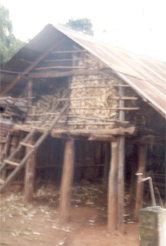
Maze storage house of Tibetans in Odisha

Tibetan monastery in Camp-IV, Odisha (2004)
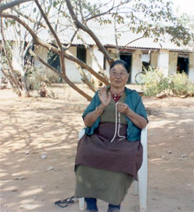
Tibetan women in Old Age Home in Camp-I, Odisha.



